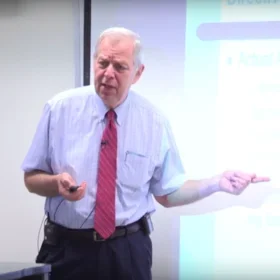By Susan Levin, Lecturer in the Negotiation and Conflict Resolution Program, School of Professional Studies
Susan Levin is a global facilitator, coach, trainer, mediator, and organization development practitioner. She is a lecturer in the Negotiation and Conflict Resolution program, where she teaches the elective course Complexity of Conflict and Change Manage, which explores how change can create conflict and how conflict requires change. Susan teaches the elective Complexity of Conflict and Change Management (NECR5095).
Hidden deep inside our brain—in the middle of the cerebrum—is a small structure that regulates our response to danger. Despite its size, it has a major impact on our behavior. Called the amygdala (Greek for “almond”), its role is to detect perceived threats in our environment and activate our body’s reaction by triggering emotional responses, such as fight or flight, or freeze or appease, with the aim of keeping us safe. Neuroscience has revealed that the amygdala acts automatically without being prompted by our conscious intention or awareness.
Part of the amygdala's job is to detect and react to even the smallest change and anticipate that the worst will happen until new more encouraging evidence emerges.
The amygdala also controls our behavior in situations that might be less life-threatening yet elicit discomfort or anxiety. The same region in the brain is activated whether we experience physical or social pain like rejection. A study at Case Western Reserve University found that exposure to rejection led participants to have an immediate drop in reasoning by 30% and a drop in IQ by 25%.
Amygdala Can Trigger Fear and Rejection
When encountering people who appear to be different than us, our amygdala may trigger a response that leads to rejection based on fear. Knowing that this is an immediate physiological reaction to difference can help us understand why we don’t tend to initially accept people who are not like us in appearance or manner. Although the degree to which this happens varies, the amygdala is on autopilot, which can lead to conflict due to misunderstanding or miscommunication.
The fact that we all are programmed by this function of the brain is a common denominator because it impacts everyone no matter what your background is or where you’re from. However, we don’t have to succumb to the power of the amygdala hijack and stay stuck there. We can shift to being curious and learning more about each other. The key is to be aware of how the instinctual brain determines our emotions that drive our reactions, and then decide what to do about it.
Prefrontal Cortex Pause
What happens in another part of the brain, the prefrontal cortex, offers some encouragement. Within about 300 milliseconds of the amygdala being triggered, the neurotransmitter (chemical messages) travels to the prefrontal cortex of the brain that is responsible for rational decision-making, perception, memory and executive functioning. This provides time to react more logically to a perceived threat. Taking a pause and a deep breath can help. It allows time to settle the emotional hijack to give you space to decide what to say or do next.
Hardwired to Resist Change
Human brains are hardwired to resist change. The evolution of neuroscience has revealed this, leading to many fascinating insights into the biological and neurological causes of human behavior and the dynamics that can cause change and lead to conflict. Change is often met with resistance. Another part of the brain—the basal ganglia, located near the center of the brain—plays a critical role in forming habits, both bad and good. Habits are built through repetition. It takes 40 to 50 repetitions on average to establish a new habit. That builds up the neural pathways so the neurons get thicker. When a change is initiated, those habitual patterns are likely to be interrupted, which can lead to discomfort and ultimately resistance. Therefore, it takes intentional will and repetition to change entrenched patterns of behavior.
Conclusion
Recognizing the power of the brain to control our reactions is the first step in understanding why humans behave the way they do in situations that appear threatening. Raising that awareness provides a window into the mystery of our survival mechanism. The next step is to overcome the fear we may feel when encountering people who seem different from us. Imagine how we could prevent conflict by staying curious, listening more, and becoming more open and inclusive in our encounters with people who have divergent perspectives, values and experiences. Despite the instinctual biology of the brain, we still have the power to consciously change.
About the Negotiation and Conflict Resolution Program:
Columbia University’s Master of Science in Negotiation and Conflict Resolution prepares students to analyze the root causes and dynamics of conflict and to transform disputes through reasoned and resourceful interventions. The program focuses on developing self-awareness, tenacity, and interpersonal competency; building common ground; opening lines of communication; ensuring representation and recognition, and building sustainable possibilities for resolution.


